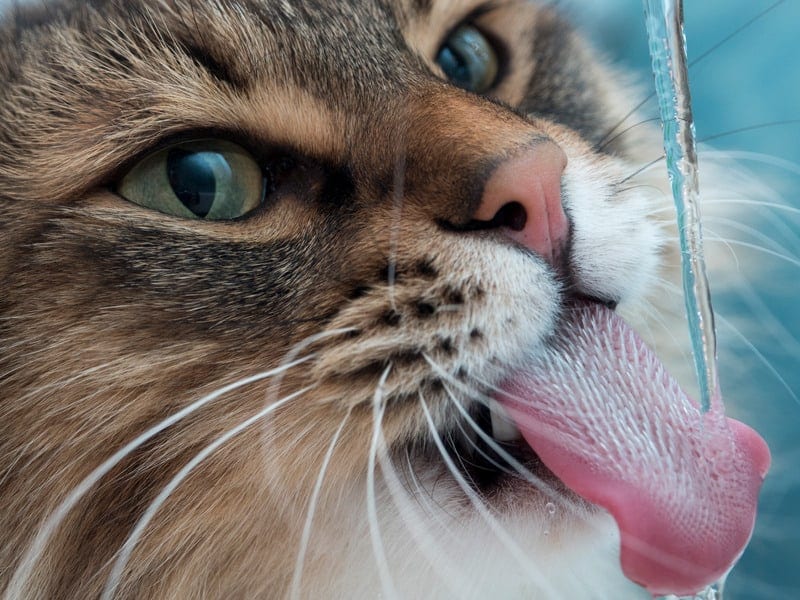Making sure that your cat stays hydrated can sometimes be a difficult task. These picky pets often ignore their water dishes, resulting in dehydration and a number of other health-related issues. However, replacing your kitten's water bowl with a cat water fountain can encourage them to drink more water, helping them stay healthier longer. Check out this information about the benefits of cat fountains, and some tips on picking them out and keeping them clean.
The Importance of Cat Hydration
Similar to big cats in the wild, house cats absorb most of the fluids they need through their food. While mice, birds and other prey provide plenty of hydration for outdoor cats, the kibbles that most indoor cats eat lacks the moisture to properly avoid cat dehydration. Making sure that your cat drinks enough water to balance out their dry-food diet is vital to their overall health.
Poor hydration can put your pet at risk for a number of cat urinary problems. Without enough water to flush out their system, minerals and bacteria can build up and cause cat urinary blockage, frequent UTIs, or other harmful disorders such as FLUTD. Drinking water is also essential to the health of cats with diabetes, hyperthyroidism, or who are recovering from surgery.
Why Do Cats Prefer Cat Fountains Over Standing Water?
While they may not care for their water dish, most cats are perfectly willing to drink from kitchen and bathroom faucets. This is a result of their natural instincts telling them that still water may not be safe due to germs or predators lurking beneath the surface. With a fountain, the fast movement, rippling sounds and reflective shimmer of the water can draw curious kittens in and entice them to drink.
Cat water fountains allow you to improve the quality of the water you give to your cats, and ensure that their water tastes and smells appealing to them. These machines allow you to control:
-
Temperature: Fountains keep your cat's water a couple degrees below room temperature to keep it more refreshing. The colder water can also prevent the growth and spread of bacteria that occurs in and around water bowls in warmer areas.
-
Circulation: Keeping your cat's water moving can prevent the stale taste and bacteria and fungus build-up that sometimes occurs in standing water. The circulation of a fountain allows you to keep your cat's water clean and safe.
-
Filtration: Cat water fountains filter out impurities from tap water to improve the quality of your cat's water. The filtration system also catches dirt, hair and other objects that can accumulate in a bowl of standing water.
Choosing fountains over water bowls has a few practical benefits for cat owners as well. Better hydration for your cat could prevent increased urination issues, meaning fewer pet messes to clean up. Cat water fountains also hold 2-3 liters of water or more, allowing you to provide all your cats with fresh water throughout the day without having to constantly refill water dishes.
Cat Fountain Maintenance
After picking out a cat fountain, you'll need to learn how to keep it clean and sanitized. Proper cat fountain maintenance is vital to the function of the machine and the health of your cat. While commercial cleaners may get the job done, the smell of bleach or other harsh chemicals may dissuade your cat from returning to the fountain for a drink. Instead, consider using natural solutions for keeping the fountain clean.
Cleaning Your Basin
Depending on the type of fountain you choose, there are several ways of keeping it sanitized. Most manufacturers recommend disassembling your cat fountain for cleaning at least once a week. Get rid of hard water deposits on a plastic fountain by liberally sprinkling salt into the basin, scrubbing it with a mesh pad and rinsing under warm water. You can spray a mixture of vinegar and lemon peels onto a stainless steel model, or combine vinegar and baking soda in a ceramic fountain to dissolve any stubborn stains.
Choosing The Right Filters
Cat fountains usually have a mechanical filter that keeps dirt and debris out of the water pump, as well as a chemical filter that absorbs toxins and impurities in the water. Some pet owners choose a carbon filter, while others opt for anti-bacterial charcoal filters. Typically, you can clean these items and other small pieces using a toothbrush and some warm soapy water, or soaking them in a bowl of distilled white vinegar for up to 30 minutes.
Each type of filter has its pros and cons. For example, the carbon option needs switched out every two weeks, while a charcoal filter can last for an entire month before it needs replaced. Also, while charcoal offers extra bacteria fighting properties, the material can start to break off into the water over time. Though this isn't toxic to your pets, they may be less inclined to drink from their fountain if they see pieces floating in the bowl.
Whichever fountain you choose, be sure to find out which type of filter it takes and how easy they are to come by. Also check that these filters are inexpensive and easy to install.
Make the Switch
Choosing running water as a drinking source is in your cat's nature, and can help them avoid a wide range of bladder and urinary issues. Exchanging your kitty's water dish for a cat water fountain is a great way to get your cat to drink more water, and ensure that they can stay happy and healthy.
About the author
Hazel Bennett is a freelance writer and blogger. She has a degree in communications and lives in Northeastern Ohio. Hazel loves writing about numerous topics and showcasing her expertise with words.






